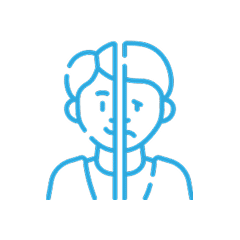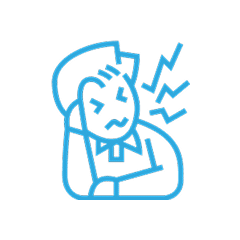
Main Types of Narcissism and How They Differ
If you google “How many types of narcissism are there?”, different numbers will pop up. It may seem that each mental health professional uses their own classification system. This confusion is caused by the fact that NPD exists on the spectrum.
What are the different types of narcissism? We’ll examine the main types of narcissism and definitions to shed light on this intricate issue. If you want to skillfully navigate through the types of narcissism, read on for an expert overview. We’ll also mention the worst type of narcissism to avoid to save yourself from emotional pain and suffering.
Understanding Narcissism
Before jumping into narcissism disorder types, let’s clarify the concept’s meaning. People often confuse the term with narcissistic traits, which are normally present in each individual.
What Is Narcissism?
Narcissistic personality disorder, or NPD, is the formal diagnosis for a severe mental health condition marked by persistent grandiosity, a craving for acclaim, profound egotism, and a lack of empathy [1]. Its symptoms commonly appear by early adulthood:
- Exaggerated sense of self-importance;
- Need for constant admiration and approval;
- Fantasies of power, success, or perfection;
- Unrealistic expectation of favorable treatment;
- Exploitation of others;
- Reluctance to consider the needs of other people;
- High sensitivity to criticism and rejection;
- Sense of deep inner insecurity;
- Envy of others;
- Intense fluctuations in mood;
- Arrogant behavior.
People can display narcissistic traits without having this mental health condition. Narcissism can negatively affect their ability to sustain a realistic self-image and form healthy, well-balanced relationships.
Our team will verify your insurance and design a plan tailored to your needs.

Introduction to Narcissism Disorder Types
Are there different types of narcissism? Though they aren’t officially recognized, mental health experts distinguish several categories to help people portray particular experiences. This results in the different types of narcissism, united by an exaggerated ego, a sense of grandiosity, fantasies about control and power, and a lack of empathy toward others.
You can’t be diagnosed with a specific NPD type, but knowing their peculiarities can help you understand the way you perceive yourself and interact with other people.
Different Types of Narcissism
How many types of narcissism is there? The numbers differ, but the main narcissism types encompass overt, covert, communal, antagonistic, and malignant. You won’t find this distinction in the DSM-5 (the current reference manual on mental health conditions), but having types of narcissism explained can promote a comprehensive interpretation of the existing individual traits.
Overt (Grandiose) Narcissism
People with grandiose narcissism seem highly ego-driven, boastful, domineering, and self-obsessed on the surface, but deep inside, they feel extremely insecure [2]. In need of constant external validation and flattery, they can manipulate and exploit others. They lack empathy and usually don’t pay attention to others’ feelings.
Overt narcissists can behave aggressively if you don’t play by their rules. Preoccupation with status, power, and wealth often induces them to engage in positions of leadership [3]. They poorly react to criticism and may struggle to notice the lapses in their demeanor. Such individuals are prone to overestimating their abilities and emotional intelligence, while undervaluing those of others.
Covert (Vulnerable) Narcissism
Vulnerable narcissism is strongly associated with introversion, making it more challenging to detect. Those with covert narcissistic traits are hypersensitive, self-focused, defensive, and avoidant [2]. Low self-esteem often encourages them to play the victim and conceal their anger and resentment behind passive aggression. They lack empathy and may react in a hostile manner to maintain a focus on themselves.
Covert narcissists seek validation and attention like those with grandiose narcissism, but their tactics are not that obvious. They may lie, gaslight, shame, and manipulate others to obtain what they want. Such people believe that others are their debtors and often blame those around them. They find it troublesome to accept criticism and often attribute their faults to conditions beyond their control.
Malignant Narcissism
Malignant narcissism is considered the most destructive among all types of narcissism. It manifests in an aggressive, manipulative, hostile, and uncompassionate attitude towards others. Since it’s located on the far end of the spectrum, some symptoms of malignant narcissism may overlap with those of antisocial personality disorder. Such people are self-absorbed and can harm others by sadistic acts of violence [4].
Lack of empathy fosters their satisfaction from the suffering and discomfort of others. Another distinct feature is paranoia or pronounced concern about possible hazards. Grandiose delusions embolden them to treat others like objects to be exploited for personal gain. They steadily overstep others’ boundaries and show no remorse for their actions.
Communal Narcissism
People with communal narcissism seem altruistic and generous, but they only keep a selfless image. Deep inside, they are driven by an urge to control [5]. Their ostentatious concern for others is rooted in a sense of superiority and entitlement. Though communal narcissists may benefit the community by engaging in charity, they often violate others’ boundaries and exploit people for personal gain.
Such individuals express compassion selectively, only in situations that can positively influence their status. This support is insincere and serves as a means to draw attention to their persona. Their behavior differs when in public and in private settings. Communal narcissists don’t care about others’ feelings and can become arrogant when they don’t get praise and admiration.
Antagonistic Narcissism
Antagonistic narcissists are driven by internal motivation to outperform others. A focus on competitiveness and victory often induces such individuals to cheat, lie, gaslight, manipulate, or devalue others. They will never lose an opportunity to take advantage of other people to satisfy their urge for domination. Antagonistic narcissists may be contemptuous, hostile, and aggressive [6].
They hardly forgive others’ weaknesses and can exploit them for personal gain. In pursuit of success, they can turn people against each other and engage in power struggles. By drawing attention to others’ mishaps, antagonistic narcissists strive to conceal their own mistakes and imperfections. An atmosphere of constant rivalry nurtures their mistrust of other people.
Contact our admissions team now to begin your path toward a brighter future.

How Many Types of Narcissism Are There?
Now that you know what are the main types of narcissism, let’s understand how many types of narcissism exist. We’ve already discussed the five most prevalent NPD subtypes: grandiose, vulnerable, malignant, communal, and antagonistic.
Some mental health professionals differentiate two additional types of narcissism psychology based on how the condition affects daily life and the capacity to build relationships [7]:
- Adaptive. Incorporates such favorable aspects of narcissism as confidence and self-sufficiency.
- Maladaptive. Relates to negative NPD traits such as arrogance, grandiosity, and exploitation of other people.
To better understand the classification of different types of narcissism, recognizing the signs and personality traits has resulted in the distinction between overt, covert, antagonistic, communal, and malignant subtypes. However, in respect of a psychiatric disorder, clinicians recognise only one term, NPD.
Recognizing the Signs of Different Types Narcissism
Each narcissism type is characterized by distinct traits, making it relatively easy to differentiate between them. Acknowledging these peculiarities can help people with NPD and their close ones to better understand thought patterns, emotions, and behaviors that may accompany this mental health condition.
Common Traits of Each Type
Let’s examine the distinctive characteristics of the five types of narcissism. Chart below demonstrates the main features of overt, covert, malignant, communal, and antagonistic narcissism.
| Type of Narcissism/Key Signs | |
| 1. Overt (Grandiose) |
|
| 2. Covert (Vulnerable) |
|
| 3. Malignant |
|
| 4. Communal |
|
| 5. Antagonistic |
|
As you can see, certain features, such as an inflated self-image, lack of empathy, and exploitative tendencies, refer to each NPD type.
The Worst Type of Narcissism: A Closer Look
Knowing how many different types of narcissism are there might make you wonder which of them has the most detrimental impact on an individual’s well-being and those surrounding them. Meet malignant narcissism, strongly associated with antisocial personality disorder.
Characteristics of Malignant Narcissism
Malignant narcissism was substantially examined by an Austrian-born American psychoanalyst, Otto Kernberg, in 1984 [4]. It is considered a core narcissistic personality disorder type marked by:
- evident antisocial behavior;
- aggression;
- sadistic actions;
- paranoid tendencies;
- overstepping others’ personal boundaries;
- threatening or bullying others;
- abusiveness;
- unsympathetic attitude;
- a need to dominate others;
- troubles with emotional regulation;
- lack of guilt or remorse.
People with malignant narcissism have impaired moral functioning and usually don’t take responsibility for their destructive actions or behaviors [8]. Except for posing a serious risk to others’ safety, the inclination to chronic suicidal tendencies can put their own welfare at risk.
Impact on Mental Health
Narcissistic personality disorder can significantly impair social and occupational functioning and heighten the likelihood of other psychiatric and substance use disorders. The condition poses a pronounced risk of suicide, making it vital to examine people with NPD for suicidal ideation on a regular basis [1]. Professional support can largely benefit people with narcissism by promoting their personal growth and psychological well-being.
Effects of Each Narcissism Type
Since you are aware of “what are different types of narcissism”, let’s see how each NPD subtype affects mental health.
- Overt narcissists can become overly anxious or depressed when they don’t get expected acclaim or admiration.
- Covert narcissists are more prone to experience negative emotions due to the inherent belief that other people owe them something.
- Communal NPD is strongly dependent on praise and validation from others and may strongly react when their expectations aren’t met.
- Malignant narcissists experience intense internal struggles and rapid mood fluctuations, which may lead to substance abuse or other destructive behaviors.
- Antagonistic narcissism causes extreme emotional swings and depressive moods, and aggressive behavior can make such people lonely.
All types of narcissism can hurt an individual’s mental health and cause problems in social and work relationships. This mental health condition often coexists with depression, substance use disorders, anxiety, and other personality disorders, including bipolar, histrionic, antisocial, borderline, and schizotypal. [9].
We’ll help you understand your options and guide you toward care.
Conclusion
We’ve reviewed “What are the types of narcissism?” and explained why the existence of several classifications causes confusion in numbers. Clinicians mainly distinguish overt, covert, communal, antagonistic, and malignant types of narcissism, but this differentiation is unofficial. Learning their peculiarities can help people navigate individual traits and understand pervasive thinking and behavioral patterns. When it comes to accurate diagnosis, there is only one term: narcissistic personality disorder.
Living narcissism to its own fate can lead to negative effects on a person’s mental health, such as anxiety, depression, and substance use. Various therapy approaches, including individual psychotherapy and group therapy, can help people with NPD increase awareness of maladaptive patterns, move toward reasonable goals, and diminish criticism of themselves and others [10].
References:
- Paroma Mitra, Tyler J. Torrico, Dimy Fluyau. Narcissistic Personality Disorder. Link: https://www.ncbi.nlm.nih.gov/books/NBK556001/. Access date: September 9, 2025.
- Marcin Zajenkowski et al. Vulnerable and Grandiose Narcissism Are Differentially Associated With Ability and Trait Emotional Intelligence. Frontiers in Psychology. August 28, 2018. Link: https://pmc.ncbi.nlm.nih.gov/articles/PMC6120976/. Access date: September 9, 2025.
- Charles A. O’Reilly, Nicholas Hall. Grandiose narcissists and decision making: Impulsive, overconfident, and skeptical of experts — but seldom in doubt. Personality and Individual Differences. August 14, 2020. Link: https://pmc.ncbi.nlm.nih.gov/articles/PMC7427600/. Access date: September 9, 2025.
- Mila Goldner-Vukov, Laurie Jo Moore. Malignant Narcissism: From Fairy Tales to Harsh Reality. Psychiatria Danubina, 2010; Vol. 22, No. 3, 392–405. Link: https://www.psychiatria-danubina.com/UserDocsImages/pdf/dnb_vol22_no3/dnb_vol22_no3_392.pdf. Access date: September 9, 2025.
- Jochen E Gebauer. Communal narcissism. Journal of Personality and Social Psychology. 2012 November; 103 (5): 854–78. Link: https://pubmed.ncbi.nlm.nih.gov/22889074/. Access date: September 9, 2025.
- Skyler T. Maples, Craig S. Neumann, Scott Barry Kaufman. Profiling narcissism: Evidence for grandiose-vulnerable and other subtypes. Journal of Research in Personality. Volume 115, April 2025. Link: https://www.sciencedirect.com/science/article/abs/pii/S0092656625000170?via%3Dihub. Access date: September 9, 2025.
- Huajian Cai. Distinguishing Between Adaptive and Maladaptive Narcissism. Handbook of Trait Narcissism. February 2018. Link: https://www.researchgate.net/publication/323322886_Distinguishing_between_Adaptive_and_Maladaptive_Narcissism. Access date: September 9, 2025.
- E. Deveze-Villarreal, C.A. López-Acevo: Malignant narcissism: a case report. Link: https://www.researchgate.net/publication/361446563_Malignant_narcissism_a_case_report_and_literature_review. Access date: September 10, 2025.
- Jenette Restivo for Harvard Health Publishing. Narcissistic personality disorder: Symptoms, diagnosis, and treatments. January 8, 2024. Link: https://www.health.harvard.edu/mind-and-mood/narcissistic-personality-disorder-symptoms-diagnosis-and-treatments. Access date: September 11, 2025.
- Igor Weinberg, Elsa Ronningstam. Narcissistic Personality Disorder: Progress in Understanding and Treatment. Link: https://pmc.ncbi.nlm.nih.gov/articles/PMC10187400/. Access date: September 11, 2025.
















